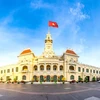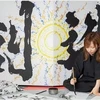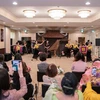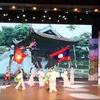 The ‘Ao dai cua chung ta’ (Our Ao dai) programme, held at Van Mieu – Quoc Tu Giam (Temple of Literature) in Hanoi on April 9 evening, kicks off a campaign aiming to promote community awareness of ‘Ao dai’ and popularise the beauty of the traditional costume in order to turn it into a symbol of Vietnamese women in the new era. The area in front of Khue Van Cac (the pavilion of the constellation of literature) becomes the stage for 15 designers to introduce more than 600 ‘Ao dai’ designs. Among them, there are renowned designers such as Minh Hanh, Ngoc Han, Lan Huong, Chu La, and Trinh Bich Thuy. (Photo: VietnamPlus)
The ‘Ao dai cua chung ta’ (Our Ao dai) programme, held at Van Mieu – Quoc Tu Giam (Temple of Literature) in Hanoi on April 9 evening, kicks off a campaign aiming to promote community awareness of ‘Ao dai’ and popularise the beauty of the traditional costume in order to turn it into a symbol of Vietnamese women in the new era. The area in front of Khue Van Cac (the pavilion of the constellation of literature) becomes the stage for 15 designers to introduce more than 600 ‘Ao dai’ designs. Among them, there are renowned designers such as Minh Hanh, Ngoc Han, Lan Huong, Chu La, and Trinh Bich Thuy. (Photo: VietnamPlus)  The 15 collections by 15 designers were inspired by 15 countries around the world. They were made from traditional materials of Vietnam such as silk and the ‘AP’ hemp cloth - a recently revived traditional material that fell into oblivion for many years. The event, co-organised by the Thang Long Institute for Cultural Research and Tinh hoa Dat Viet Magazine, features the participation of more than 400 models, actors, and guests, including the wives of the ambassadors of Italy, India, Laos and Belarus. ‘Ao dai’ has long been a traditional costume and a typical cultural feature of Vietnam. Through ups and downs with constant changes, ‘Ao dai’ still honours the gracefulness and elegance of Vietnamese women. (Photo: VietnamPlus)
The 15 collections by 15 designers were inspired by 15 countries around the world. They were made from traditional materials of Vietnam such as silk and the ‘AP’ hemp cloth - a recently revived traditional material that fell into oblivion for many years. The event, co-organised by the Thang Long Institute for Cultural Research and Tinh hoa Dat Viet Magazine, features the participation of more than 400 models, actors, and guests, including the wives of the ambassadors of Italy, India, Laos and Belarus. ‘Ao dai’ has long been a traditional costume and a typical cultural feature of Vietnam. Through ups and downs with constant changes, ‘Ao dai’ still honours the gracefulness and elegance of Vietnamese women. (Photo: VietnamPlus)  Designer Minh Hanh, General Director of the programme, said if silk has long been a popular material for making ‘Ao dai’, now the public come to know another ‘wonderful’ material - cloth made from hemp fibre, which is a friendly and comfortable material. ‘Ao dai’ has established itself as a cultural symbol connected with the image of Vietnamese women. It has seen significant changes through the years but its traditional characteristics have still been preserved, thus helping to enhance the charming beauty of Vietnamese women. In the mind of Vietnamese people and the eyes of international friends, ‘Ao dai’ is also a representative of Vietnamese culture and quintessence. (Photo: VietnamPlus)
Designer Minh Hanh, General Director of the programme, said if silk has long been a popular material for making ‘Ao dai’, now the public come to know another ‘wonderful’ material - cloth made from hemp fibre, which is a friendly and comfortable material. ‘Ao dai’ has established itself as a cultural symbol connected with the image of Vietnamese women. It has seen significant changes through the years but its traditional characteristics have still been preserved, thus helping to enhance the charming beauty of Vietnamese women. In the mind of Vietnamese people and the eyes of international friends, ‘Ao dai’ is also a representative of Vietnamese culture and quintessence. (Photo: VietnamPlus)  Joining models in the show are outstanding actresses of Vietnam. The word ‘ao dai’ has been included in the Oxford dictionary, which explains ‘ao dai’ is a Vietnamese woman’s long-sleeved tunic with ankle-length panels at front and back, worn over trousers. The tunic is worn on various occasions, from family gatherings to diplomatic events, art performances, festivals, especially the traditional Tet (Lunar New Year) holiday, fashion shows and beauty contests, both at home and abroad. While it is simple to wear, the costume highlights the beauty of women. ‘Ao dai’, therefore, has become a popular attire of Vietnamese women. It has been an endless source of inspiration for movies, music and fine art. (Photo: VietnamPlus)
Joining models in the show are outstanding actresses of Vietnam. The word ‘ao dai’ has been included in the Oxford dictionary, which explains ‘ao dai’ is a Vietnamese woman’s long-sleeved tunic with ankle-length panels at front and back, worn over trousers. The tunic is worn on various occasions, from family gatherings to diplomatic events, art performances, festivals, especially the traditional Tet (Lunar New Year) holiday, fashion shows and beauty contests, both at home and abroad. While it is simple to wear, the costume highlights the beauty of women. ‘Ao dai’, therefore, has become a popular attire of Vietnamese women. It has been an endless source of inspiration for movies, music and fine art. (Photo: VietnamPlus)  The Ao dais are adorned with accessories imbued with the traditional culture of Vietnam. ‘Ao dai’ has been an endless source of inspiration for movies, music and fine art, and also part of the soul of Vietnamese people both at home and abroad. The traditional dress has played an important role in promoting Vietnam’s tourism. Tourists to the country, especially women, often bring home ‘ao dai’ as a special souvenir. Over the past years, many designers have breathed a new life into ‘ao dai’ with new designs. Such designers as Minh Hanh, Vo Viet Chung and Si Hoang have contributed to promoting ‘ao dai’ in the regional and international fashion industry. (Photo: VietnamPlus)
The Ao dais are adorned with accessories imbued with the traditional culture of Vietnam. ‘Ao dai’ has been an endless source of inspiration for movies, music and fine art, and also part of the soul of Vietnamese people both at home and abroad. The traditional dress has played an important role in promoting Vietnam’s tourism. Tourists to the country, especially women, often bring home ‘ao dai’ as a special souvenir. Over the past years, many designers have breathed a new life into ‘ao dai’ with new designs. Such designers as Minh Hanh, Vo Viet Chung and Si Hoang have contributed to promoting ‘ao dai’ in the regional and international fashion industry. (Photo: VietnamPlus)  ‘Ao dai’ has been the traditional costume of Vietnamese people for many generations. Going through numerous ups and downs in history, it has established itself as a part of the country’s cultural heritage. The exact origin of ‘ao dai’ is unknown though researchers concluded that its history dates back to thousands of years ago with different designs. The oldest image preserved so far of ‘ao dai’ was ‘Ao Giao Linh’ (cross-collared robe) in about 1744 when South Vietnam was ruled by Lord Nguyen Phuc Khoat while the North was under the control of Trinh Lords. It was then worn with black skirts and a cloth belt. (Photo: VietnamPlus)
‘Ao dai’ has been the traditional costume of Vietnamese people for many generations. Going through numerous ups and downs in history, it has established itself as a part of the country’s cultural heritage. The exact origin of ‘ao dai’ is unknown though researchers concluded that its history dates back to thousands of years ago with different designs. The oldest image preserved so far of ‘ao dai’ was ‘Ao Giao Linh’ (cross-collared robe) in about 1744 when South Vietnam was ruled by Lord Nguyen Phuc Khoat while the North was under the control of Trinh Lords. It was then worn with black skirts and a cloth belt. (Photo: VietnamPlus)  Via their collections, designers wish ‘Ao dai’ to be known farther and wider and get established in human civilisation. Experts said that ‘Ao dai’ is not only a great work of art adding to the national beauty but also a symbol of the identity and spirit of Vietnam. The traditional dress is suitable for all ages. It has become the standard costume on formal occasions or national holidays, weddings, the Lunar New Year festival, graduation days or in important competitions. Many experts held that the traditional dress offers a comprehensive insight into history. Through its function and the habit of using, ‘Ao dai’ reflects the social and cultural value, art and cultural identity of the Vietnamese nation. (Photo: VietnamPlus)
Via their collections, designers wish ‘Ao dai’ to be known farther and wider and get established in human civilisation. Experts said that ‘Ao dai’ is not only a great work of art adding to the national beauty but also a symbol of the identity and spirit of Vietnam. The traditional dress is suitable for all ages. It has become the standard costume on formal occasions or national holidays, weddings, the Lunar New Year festival, graduation days or in important competitions. Many experts held that the traditional dress offers a comprehensive insight into history. Through its function and the habit of using, ‘Ao dai’ reflects the social and cultural value, art and cultural identity of the Vietnamese nation. (Photo: VietnamPlus)  Designer Hue Thi (Can Tho city) opens the show with a collection deeply imbued with traditional identities of Vietnam, while designs by Trung Beret from Dak Lak province demonstrate the tranquility of Laos. Tran Thanh Man from the ancient royal city of Hue is inspired by the royalty of Thailand, Cao Duy (Tien Giang province) by the wonders of China, and Ngoc Han (Hanoi) the imperial patterns of India. Meanwhile, Tran Thien Khanh (Hue) creates images of the Republic of Korea through Hanbok images, Ha Duy (Hanoi) finds inspiration in the architecture of Japan, Trinh Bich Thuy (Hanoi) tells Greek mythology, Cong Huan (Ho Chi Minh City) pays attention to the Statue of Liberty of the US, and Lan Huong (Hanoi) shows off the heritage beauty of German architecture. (Photo: VietnamPlus)
Designer Hue Thi (Can Tho city) opens the show with a collection deeply imbued with traditional identities of Vietnam, while designs by Trung Beret from Dak Lak province demonstrate the tranquility of Laos. Tran Thanh Man from the ancient royal city of Hue is inspired by the royalty of Thailand, Cao Duy (Tien Giang province) by the wonders of China, and Ngoc Han (Hanoi) the imperial patterns of India. Meanwhile, Tran Thien Khanh (Hue) creates images of the Republic of Korea through Hanbok images, Ha Duy (Hanoi) finds inspiration in the architecture of Japan, Trinh Bich Thuy (Hanoi) tells Greek mythology, Cong Huan (Ho Chi Minh City) pays attention to the Statue of Liberty of the US, and Lan Huong (Hanoi) shows off the heritage beauty of German architecture. (Photo: VietnamPlus)  Many experts have been for many years seeking the recognition of ‘Ao dai’ as a national intangible cultural heritage. The dress has established itself as a cultural symbol connected with the image of Vietnamese women. It has seen significant changes through the years but its traditional characteristics have still been preserved. During the 19th century, the outfit evolved into the ‘Ao Ngu Than’ (five-panel gown). It then has two flaps sewn together in the back, two flaps in the front, and a flap hidden underneath the main front flap. The outfit had slits on both sides, features preserved in the later ‘Ao dai’. However, ‘Ao Ngu Than’ is shorter and not so tight as the modern ‘Ao dai’. (Photo: VietnamPlus)
Many experts have been for many years seeking the recognition of ‘Ao dai’ as a national intangible cultural heritage. The dress has established itself as a cultural symbol connected with the image of Vietnamese women. It has seen significant changes through the years but its traditional characteristics have still been preserved. During the 19th century, the outfit evolved into the ‘Ao Ngu Than’ (five-panel gown). It then has two flaps sewn together in the back, two flaps in the front, and a flap hidden underneath the main front flap. The outfit had slits on both sides, features preserved in the later ‘Ao dai’. However, ‘Ao Ngu Than’ is shorter and not so tight as the modern ‘Ao dai’. (Photo: VietnamPlus)  Via their designs, Cao Minh Tien (Hanoi) shows his love for the French language, Thanh Thuy (Hanoi) wants to depict the romance and gallantry of Italians, Phuong Thanh (HCM City) describes the beauty of tulip, the flower symbol of the Netherlands, Chu La (Hanoi) introduces the Spanish culture, and Minh Hanh (HCM City) illustrates the great culture of Russia. ‘Ao dai’ is worn on various occasions, from family gatherings to diplomatic events, art performances, festivals, especially the traditional Tet (Lunar New Year) holiday, fashion shows and beauty contests, both at home and abroad. Ao dai is not complicated to put on. While it is simple to wear, the dress highlights the beauty of women. (Photo: VietnamPlus)
Via their designs, Cao Minh Tien (Hanoi) shows his love for the French language, Thanh Thuy (Hanoi) wants to depict the romance and gallantry of Italians, Phuong Thanh (HCM City) describes the beauty of tulip, the flower symbol of the Netherlands, Chu La (Hanoi) introduces the Spanish culture, and Minh Hanh (HCM City) illustrates the great culture of Russia. ‘Ao dai’ is worn on various occasions, from family gatherings to diplomatic events, art performances, festivals, especially the traditional Tet (Lunar New Year) holiday, fashion shows and beauty contests, both at home and abroad. Ao dai is not complicated to put on. While it is simple to wear, the dress highlights the beauty of women. (Photo: VietnamPlus)  ‘Non’ (conical hat), a popular headwear of Vietnamese people in the past, becomes an interesting accessory for new ‘Ao dai’ designs. Experts said that ‘Ao dai’ is not only a great work of art adding to the national beauty but also a symbol of the identity and spirit of Vietnam. The traditional dress is suitable for all ages. It has become the standard costume on formal occasions or national holidays, weddings, the Lunar New Year festival, graduation days or in important competitions. Many experts held that the traditional dress offers a comprehensive insight into the country’s history. Through its function and the habit of using, ‘Ao dai’ reflects the social and cultural value, art and cultural identity of the Vietnamese nation. (Photo: VietnamPlus)
‘Non’ (conical hat), a popular headwear of Vietnamese people in the past, becomes an interesting accessory for new ‘Ao dai’ designs. Experts said that ‘Ao dai’ is not only a great work of art adding to the national beauty but also a symbol of the identity and spirit of Vietnam. The traditional dress is suitable for all ages. It has become the standard costume on formal occasions or national holidays, weddings, the Lunar New Year festival, graduation days or in important competitions. Many experts held that the traditional dress offers a comprehensive insight into the country’s history. Through its function and the habit of using, ‘Ao dai’ reflects the social and cultural value, art and cultural identity of the Vietnamese nation. (Photo: VietnamPlus)  The ‘Our Ao dai’ event is part of a campaign titled ‘Ao dai - Heritage of Vietnam’ launched by the Vietnam Women’s Union Central Committee with a view to further promoting the beauty of the traditional costume and turning it into a symbol of Vietnamese women in the new era. ‘Ao dai’ has long been a traditional costume and a typical cultural feature of the country. However, the dress has yet to be named in the list of national heritage though the inscription is the prerequisite for making a dossier to seek UNESCO recognition of ‘Ao dai’ as part of the world’s intangible cultural heritage. (Photo: VietnamPlus)
The ‘Our Ao dai’ event is part of a campaign titled ‘Ao dai - Heritage of Vietnam’ launched by the Vietnam Women’s Union Central Committee with a view to further promoting the beauty of the traditional costume and turning it into a symbol of Vietnamese women in the new era. ‘Ao dai’ has long been a traditional costume and a typical cultural feature of the country. However, the dress has yet to be named in the list of national heritage though the inscription is the prerequisite for making a dossier to seek UNESCO recognition of ‘Ao dai’ as part of the world’s intangible cultural heritage. (Photo: VietnamPlus)  Decorated with images of Hanbok - the traditional outfit of Korean people, Ao dai designs by Tran Thien Khanh convey an impression of the cultural identity of the Republic of Korea. In the 1930s, Vietnam was under the rule of French colonialists and influenced by Western culture. The tailor-artist Cat Tuong (or Le Mur) made a reform in ‘ao dai’ making when she combined Western dress style with the traditional ‘ao dai’. The new outfit was resized to fit perfectly women’s body with a floor-length and curved flap, a pinched waist, along with a Western-style heart-shaped collar, and puffed sleeves. However, this design was not welcomed by the public who said it did not match Vietnamese traditions. (Photo: VietnamPlus)
Decorated with images of Hanbok - the traditional outfit of Korean people, Ao dai designs by Tran Thien Khanh convey an impression of the cultural identity of the Republic of Korea. In the 1930s, Vietnam was under the rule of French colonialists and influenced by Western culture. The tailor-artist Cat Tuong (or Le Mur) made a reform in ‘ao dai’ making when she combined Western dress style with the traditional ‘ao dai’. The new outfit was resized to fit perfectly women’s body with a floor-length and curved flap, a pinched waist, along with a Western-style heart-shaped collar, and puffed sleeves. However, this design was not welcomed by the public who said it did not match Vietnamese traditions. (Photo: VietnamPlus)  After only four years of popularity, the 'Ao Dai Le Mur' was temporarily put to rest as painter Le Pho removed all western influence from its design and replaced it with several renditions of the four-panel gown. From this point on until the 1950s, his style of ‘ao dai’ remained popular as it stood well with traditional ideology. In the 1960s, the costume’s popularity reached its pinnacle, especially in the south. Dung Dakao, a Saigon-based designer altered the traditional costume, adding raglan sleeves and connecting the front panel of ‘ao dai’ with the back, with the ingenious use of buttons that went from the collar to the armpit and all the way down to the hip, creating a comfortable dress. (Photo: VietnamPlus)
After only four years of popularity, the 'Ao Dai Le Mur' was temporarily put to rest as painter Le Pho removed all western influence from its design and replaced it with several renditions of the four-panel gown. From this point on until the 1950s, his style of ‘ao dai’ remained popular as it stood well with traditional ideology. In the 1960s, the costume’s popularity reached its pinnacle, especially in the south. Dung Dakao, a Saigon-based designer altered the traditional costume, adding raglan sleeves and connecting the front panel of ‘ao dai’ with the back, with the ingenious use of buttons that went from the collar to the armpit and all the way down to the hip, creating a comfortable dress. (Photo: VietnamPlus)  All the ‘Ao dai’ designs shown at the ‘Our Ao dai’ programme are made from silk and hemp cloth, which are traditional materials of Vietnam. In Hue city of the central province of Thua Thien-Hue, an ‘Ao dai’ festival has formed an indispensable part of the Hue Festival, gathering various collections of the dress by famous designers. Currently, 'Ao dai Hue' has become a special tourism product that has left good impression on both domestic and foreign visitors, contributing to the preservation and promotion of the country’s traditional cultural values. Via the costume, the traditional culture of the ancient capital city has been popularised among domestic and international tourists. (Photo: VietnamPlus)
All the ‘Ao dai’ designs shown at the ‘Our Ao dai’ programme are made from silk and hemp cloth, which are traditional materials of Vietnam. In Hue city of the central province of Thua Thien-Hue, an ‘Ao dai’ festival has formed an indispensable part of the Hue Festival, gathering various collections of the dress by famous designers. Currently, 'Ao dai Hue' has become a special tourism product that has left good impression on both domestic and foreign visitors, contributing to the preservation and promotion of the country’s traditional cultural values. Via the costume, the traditional culture of the ancient capital city has been popularised among domestic and international tourists. (Photo: VietnamPlus)  Experts held that in the country’s cultural and art history, Ao dai is not only a great work of art adding to the national beauty but also a symbol of the country’s identity and spirit. Nguyen Phuong Nga, Vietnamese Ambassador to the UN from 2014 to 2018, says that ‘Ao dai’ has become part of the national soul anywhere, and it deserves to be honoured as an intangible cultural heritage of humanity as it represents traditional values of Vietnam as well as talents of local artisans. To contribute to promoting ‘Ao dai’, she presented two ‘Ao dai’ which she wore in diplomatic events to the Vietnamese Women’s Museum. (Photo: VietnamPlus)
Experts held that in the country’s cultural and art history, Ao dai is not only a great work of art adding to the national beauty but also a symbol of the country’s identity and spirit. Nguyen Phuong Nga, Vietnamese Ambassador to the UN from 2014 to 2018, says that ‘Ao dai’ has become part of the national soul anywhere, and it deserves to be honoured as an intangible cultural heritage of humanity as it represents traditional values of Vietnam as well as talents of local artisans. To contribute to promoting ‘Ao dai’, she presented two ‘Ao dai’ which she wore in diplomatic events to the Vietnamese Women’s Museum. (Photo: VietnamPlus)  According to Associate Professor and Doctor Bui Hoai Son, Director of the Vietnam Institute for Culture and Arts Studies, once ‘Ao dai’ is named in the list of national intangible cultural heritage and earns the global recognition, it will be better known and Vietnam’s copyright on the dress will be affirmed. Although Vietnamese people, both at home and abroad, and the international community are aware that ‘Ao dai’ belongs to the country, it remains just oral recognition. Therefore, it is high time to build a dossier for the dress to be officially named as cultural heritage, nationally and globally, thus contributing to protecting the country’s cultural sovereignty. (Photo: VietnamPlus)
According to Associate Professor and Doctor Bui Hoai Son, Director of the Vietnam Institute for Culture and Arts Studies, once ‘Ao dai’ is named in the list of national intangible cultural heritage and earns the global recognition, it will be better known and Vietnam’s copyright on the dress will be affirmed. Although Vietnamese people, both at home and abroad, and the international community are aware that ‘Ao dai’ belongs to the country, it remains just oral recognition. Therefore, it is high time to build a dossier for the dress to be officially named as cultural heritage, nationally and globally, thus contributing to protecting the country’s cultural sovereignty. (Photo: VietnamPlus)  In early March this year, women across the country were encouraged to wear ‘Ao dai’ as part of a national event titled ‘Ao dai - Cultural Heritage of Vietnam’. The event, co-launched by the Vietnam Women’s Union Central Committee and the Ministry of Culture, Sports and Tourism, aimed to celebrate the 90th anniversary of the union’s establishment and 110th anniversary of International Women’s Day (March 8). The traditional costume is suitable for all ages. It has become the standard costume on formal occasions or national holidays, weddings, New Year festival, and graduation day. It has also made a great contribution to promoting the image of Vietnamese women around the world. (Photo: VietnamPlus)
In early March this year, women across the country were encouraged to wear ‘Ao dai’ as part of a national event titled ‘Ao dai - Cultural Heritage of Vietnam’. The event, co-launched by the Vietnam Women’s Union Central Committee and the Ministry of Culture, Sports and Tourism, aimed to celebrate the 90th anniversary of the union’s establishment and 110th anniversary of International Women’s Day (March 8). The traditional costume is suitable for all ages. It has become the standard costume on formal occasions or national holidays, weddings, New Year festival, and graduation day. It has also made a great contribution to promoting the image of Vietnamese women around the world. (Photo: VietnamPlus)  ‘Ao dai’ has seen significant changes throughout history, but its traditional characteristics have still been preserved, contributing to enhancing the charming beauty of Vietnamese women. It has been an endless source of inspiration for movies, music and fine art, and also formed part of the soul of Vietnamese people both at home and abroad. In the mind of Vietnamese people and the eyes of international friends, Ao Dai is a symbol of Vietnamese culture and quintessence. The word “Ao Dai” has been included in the Oxford dictionary, which explains that ‘Ao dai’ is a Vietnamese woman’s long-sleeved tunic with ankle-length panels at front and back, worn over trousers. (Photo: VietnamPlus)
‘Ao dai’ has seen significant changes throughout history, but its traditional characteristics have still been preserved, contributing to enhancing the charming beauty of Vietnamese women. It has been an endless source of inspiration for movies, music and fine art, and also formed part of the soul of Vietnamese people both at home and abroad. In the mind of Vietnamese people and the eyes of international friends, Ao Dai is a symbol of Vietnamese culture and quintessence. The word “Ao Dai” has been included in the Oxford dictionary, which explains that ‘Ao dai’ is a Vietnamese woman’s long-sleeved tunic with ankle-length panels at front and back, worn over trousers. (Photo: VietnamPlus)  The exact origin of ‘Ao dai’ is unknown though some researchers said it dates back to thousands of years ago with different designs. The dress is worn on various occasions, from family gatherings to diplomatic events, art performances, festivals, especially the traditional Tet (Lunar New Year) holiday, fashion shows, as well as beauty contests. It is not complicated to put on ‘Ao dai’. The costume is simple to wear but still highlights the beauty of women. ‘Ao dai’, therefore, has become a popular attire of Vietnamese women. The traditional outfit has played an important role in promoting tourism. Foreign visitors to the country, especially women, often bring home ‘Ao dai’ as a special souvenir. (Photo: VietnamPlus)
The exact origin of ‘Ao dai’ is unknown though some researchers said it dates back to thousands of years ago with different designs. The dress is worn on various occasions, from family gatherings to diplomatic events, art performances, festivals, especially the traditional Tet (Lunar New Year) holiday, fashion shows, as well as beauty contests. It is not complicated to put on ‘Ao dai’. The costume is simple to wear but still highlights the beauty of women. ‘Ao dai’, therefore, has become a popular attire of Vietnamese women. The traditional outfit has played an important role in promoting tourism. Foreign visitors to the country, especially women, often bring home ‘Ao dai’ as a special souvenir. (Photo: VietnamPlus) VNA



















